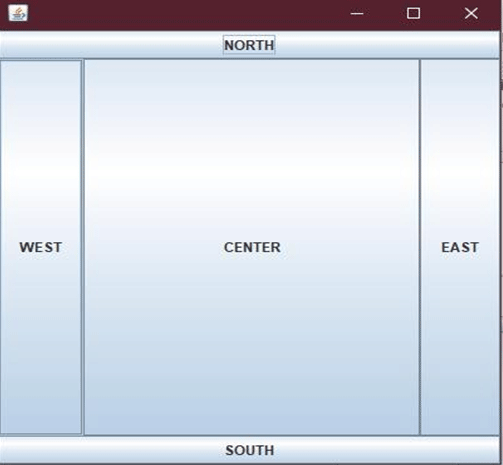

private JButton nb new JButton(North Button). Components laid out with a FlowLayout Example 11-2. managers like FlowLayout and GridLayout to the special purpose BorderLayout and CardLayout to the. Pixels between components, both horizontally and vertically.Įxample 11-2 is a short program that arranges buttons usingĪ FlowLayout layout manager Figure 11-3 shows the resulting output. Constructs a new FlowLayout with the specified alignment and a default 5-unit horizontal and vertical gap. You do not specify a different layout manager, a panel uses aįlowLayout that centers its rows and leaves five See the constructor FlowLayout (int align). 3) Avoid using setPreferredSize 4) tVisible (true) should be last, right after frame.pack (). 2) Add ASCII art or a simple drawing of the way you expect the GUI to appear, and how it should appear when resized. Note that FlowLayout is theĭefault layout manager for JPanel containers. 1) For better help sooner, edit to add a minimal reproducible example. If there is not enough room in the container, some components If there is extra space, FlowLayout leaves itīlank. but if you add complex/large components into flow layout it might fail as. Into the container it leaves each component at its preferred size. Border layout requires a constraint for every addition (like the center or. Vertical space the layout manager leaves between components.įlowLayout makes no attempt to fit its components You can also specify the amount of horizontal and Specify whether the rows should be left-justified, centered, or Remaining in the current row for the next component, theĪ new row. Layout manager arranges its children like words on a page: from left Layouts change when you resize the window. The figuresĪre produced using the ShowBean class from Example 11-30 you can use this program to experiment with ForĮxample, you can use a GridLayout to arrange 10īuttons into two columns within a container, and then use aīorderLayout to position those two columns againstĭemonstrate all the important layout managers, using a short exampleĪnd a screen shot of the layout produced by the example. Their power becomes apparent when combined, however. Have set the layout manager, you can usually forget about it.įollowing sections, most of the predefined AWT layout managers haveįairly simple layout policies that may not seem like much use on Manager object to the setLayout( ) method of theĬontainer that is to be managed the container invokes the various Manager classes take different constructor arguments to specify the Layout manager as you would any other object. GUIs typically rely on AWT layout managers. Although Swing defines many new components, Swing Note that BoxLayout is the only layout managerĭefined by Swing.
FLOWLAYOUT WITH BUTTONS LIKE BORDERLAYOUT CODE
The sections that followĭemonstrate the use of each of the AWT and Swing layout managers. When I run your code on Windows, the Minimize/Resize/Quit buttons have no spacing and you need to add Box. Layout policy and automatically arranges the components within aĬontainer according to that policy. LayoutManager implementation enforces a specific Management and is almost always performed by a special Import ĮventQueue.Once you have created your components andĪdded them to containers, the next step is to arrange thoseĬomponents within the container. I'm not saying a more complex requirement might benefit from a compounding solution (I'd be tempted to put the min/max/close and tab buttons in there own containers), but as a starting point, it's relatively simple. So, this solution is a single container, with a single layout manager. BorderLayout GridLayout which places components in rows and columns after resizing all.


Gbc.anchor = GridBagConstraints.BASELINE_TRAILING Īrrgggh, the complexity burns, it burns 😱 sarcasm FlowLayout, which places components in a simple left-to-right order. GridBagConstraints gbc = new GridBagConstraints() I would highly recommend GridBagLayout, it's one of the most flexible and configurable layout managers available, but it does bring with it complexity Following is the declaration for class public class FlowLayout extends Object implements LayoutManager, Serializable Field Following are the fields for class static int CENTER This value indicates that each row of components should be centered.


 0 kommentar(er)
0 kommentar(er)
